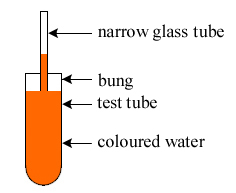A home made thermometer

Susie made a water thermometer. She tested her thermometer at different temperatures.

10° C 30° C 70° C
| a) | In the tube below, draw the water level to show a temperature of 50°C. |
 |
|
| b) |
What is the maximum temperature Susie could measure with her water thermometer?
(A) 90° C (B) 100° C (C) 110° C (D) 120° C (E) 130° C
|
|
c)
|
Why does the liquid move up the tube as the temperature increases?
|
|
d)
|
Why could you not use this thermometer to measure temperatures below 0° C?
|

